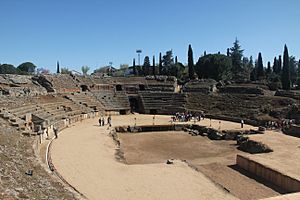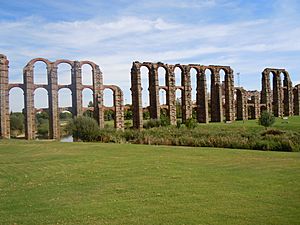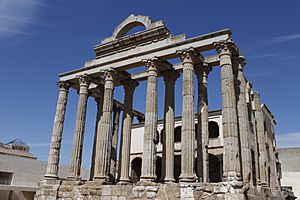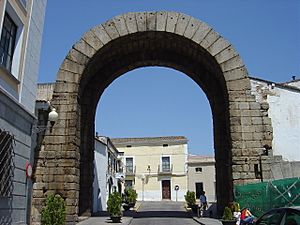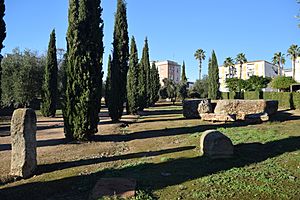Augusta Emerita facts for kids
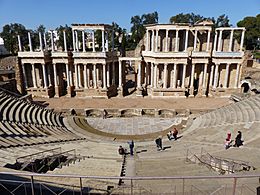
Roman theater in Mérida
|
|
| Location | Mérida, Extremadura, Spain |
|---|---|
| Region | Lusitania |
| Coordinates | 38°55′N 6°20′W / 38.917°N 6.333°W |
| Type | Settlement |
| History | |
| Founded | 25 BC |
| Cultures | Roman |
| Official name | Archaeological Ensemble of Mérida |
| Type | Cultural |
| Criteria | iii, iv |
| Designated | 1993 (17th session) |
| Reference no. | 664 |
| Region | Europe and North America |
Augusta Emerita was an important Roman city. It was founded in 25 BC where Mérida, Spain is today. The Roman Emperor Augustus created the city. He wanted a place for soldiers who had finished fighting in the Cantabrian Wars. These soldiers were called Emeriti.
Augusta Emerita was one of the biggest cities in Hispania (what is now Spain). It was the capital of the Roman province of Lusitania. This area covered over 20,000 square kilometers (7,700 sq mi). The city had three aqueducts to bring water and two fora (public squares).
The city was built in a great spot. It was near a crossing of the Guadiana river. Roman roads connected it to other major cities. These included Lisbon, Seville, Córdoba, and Toledo.
Today, the Archaeological Ensemble of Mérida is a huge ancient site. It is one of the largest in Spain. UNESCO made it a World Heritage Site in 1993. This means it is a very special place that needs to be protected.
Contents
- Amazing Roman Buildings
- The Roman Theatre: A Place for Shows
- The Roman Amphitheatre: Gladiator Fights
- The Roman Circus: Chariot Races
- Roman Bridge over the Guadiana: A Key Crossing
- Los Milagros Aqueduct: A Water Wonder
- Rabo de Buey-San Lázaro Aqueduct: Another Water Source
- Temple of Diana: A Grand Temple
- Arch of Trajan: A Grand Entrance
- Mithraeum House: A Roman Home
- Los Columbarios: Ancient Burial Sites
- Other Cool Archaeological Sites
- Protected Sites
- Images for kids
- See also
Amazing Roman Buildings
The Roman Theatre: A Place for Shows
The theatre was built between 16 and 15 BC. It was a gift from a Roman leader named Marcus Vipsanius Agrippa. About 6,000 people could sit there to watch plays.
It was fixed up a few times over the years. One big change happened around 330-340 AD. New decorations and a walkway were added. Later, when Christianity became the main religion, plays were seen as wrong. The theatre was left empty and covered with dirt. Only the top rows of seats could be seen. People in Spain called these "The Seven Chairs." They believed Moorish kings used them to decide the city's future.
The Roman Amphitheatre: Gladiator Fights
The amphitheatre opened in 8 BC. It was used for exciting gladiator fights. People also watched staged animal hunts there. It had an oval shape with seats for about 15,000 people. The seats were divided by social class. The most important people sat closest to the action.
Today, only the lowest seats remain. Once the games stopped, people took stones from the upper seats. They used these stones to build other things.
The Roman Circus: Chariot Races
The circus in Augusta Emerita was built around 20 BC. It was used for many years before it was officially opened. This probably happened when Emperor Tiberius was in charge. The circus was outside the city walls. It was next to the road that went to Córdoba and Toledo.
It had a long U-shape, like a racetrack. A long wall down the middle, called a spina, divided the track. This allowed for continuous chariot racing with two-horse or four-horse chariots. The track was surrounded by seating. At about 400 meters (1,300 ft) long and 100 meters (330 ft) wide, it was the city's biggest building. It could hold about 30,000 people. This was almost the entire city's population! Mérida's circus was like a smaller version of Rome's famous Circus Maximus.
Roman Bridge over the Guadiana: A Key Crossing
This bridge was super important for the city. It connected to the main east-west street, called the Decumanus Maximus. The bridge was built at a shallow part of the Guadiana river. There was a central island that split the river into two parts.
The original bridge was not one continuous structure. It had two parts joined at the island. A flood in 1603 damaged it. After that, new arches were added in the 17th century. The Romans also made the bridge longer over time. They added more arches so the road wouldn't get cut off during floods. The bridge is 792 meters (2,598 ft) long. This makes it one of the longest ancient bridges still standing!
Los Milagros Aqueduct: A Water Wonder
This aqueduct was built in the early 1st century BC. It brought water to Mérida from the Proserpina Dam, about 5 kilometers (3.1 mi) away. The arches of the aqueduct are still in good shape. Especially the part that crosses the Albarregas river valley.
It's called Acueducto de los Milagros, which means "Miraculous Aqueduct." People say it's a miracle that it's still standing today!
Rabo de Buey-San Lázaro Aqueduct: Another Water Source
This aqueduct brought water from streams and underground springs north of the city. The underground part is very well preserved. But the part that crossed the Albarregas valley is mostly gone. Only three pillars and their arches remain. They are near the Roman circus.
Temple of Diana: A Grand Temple
This temple was a public building in the city's main square, the Roman forum. It's one of the best-preserved religious buildings. Even though it's called the "Temple of Diana," it was actually built to honor the Roman emperors. It was built in the late 1st century BC. In the 1500s, part of it was used to build a palace.
The temple is rectangular and surrounded by columns. It faces the front of the city's Forum. It was mostly built from granite.
Arch of Trajan: A Grand Entrance
This arch was likely an entrance to the provincial forum. It was on the Cardo Maximus, one of the city's main streets. It connected to the municipal forum. The arch is made of granite and used to be covered in marble. It is about 14 meters (46 ft) high. People think it was a victory arch. Its name is just a guess, as the original name was lost long ago.
Mithraeum House: A Roman Home
This building was found by chance in the early 1960s. It's on the side of Mount San Albín. It's called "Mithraeum House" because it's close to where a Mithraeum (a temple for the god Mithras) was found. The house was built with rough stones. It was a peristyle house, meaning it had an inner garden. One room has a famous mosaic showing nature's elements like rivers and winds.
This house was a Roman domus (a type of house). The actual Mithraeum remains are uphill from here. They were found in a plot where a bullring now stands. This site has given us great examples of Mithraism, an ancient Roman religion. Some sculptures found here are in very good condition. This makes experts think they were hidden on purpose.
Los Columbarios: Ancient Burial Sites
The Columbaria are two roofless burial buildings. They were part of a graveyard outside the Roman city walls. These are the best examples of burial buildings in Emerita. They were built with rough stone and granite. Both buildings still have the names of the Roman families who owned them. These were the gens Voconia and the gens Iulia families.
Today, this area is a park. It helps people learn about how Romans in Mérida thought about death. There are quotes from famous thinkers and explanations of Roman burial customs. Two Roman tombs are also on the site. You can get to this area through the Mérida Mithraeum House.
Other Cool Archaeological Sites
- Amphitheater House: This name refers to two houses found next to the amphitheater. One is the "Water Tower House," and the other is the "Amphitheatre House."
- Archaeological site of Morerías: This area used to be an Arab neighborhood. But Roman remains were also found here. Today, a modern building stands above it.
- Roman bridge over the river Albarregas: This bridge was built during Emperor Augustus's time. It crossed the Albarregas river before it flowed into the Guadiana. The famous Via de la Plata road to Astorga started here. It is 145 meters (476 ft) long.
- Forum Gate: Built in the 1st century. It was rebuilt using pieces found at the site. Many of these pieces are now in the National Museum of Roman Art. It was near the Temple of Diana.
- San Lázaro Roman Baths: These baths are in a park. Important citizens used them after events at the Roman Circus.
- Roman Baths and snow pit in Reyes Huertas Street: These were unique baths that used snow and cold water. Romans also used them to store food that spoiled easily.
- Crypt of Santa Eulalia: This is an interesting site under the Basilica of Santa Eulalia. It shows the history of this church from its beginning.
- Santa Eulalia Obelisk: Built in the 17th century to honor Saint Eulalia of Mérida, the patron saint of Mérida. It uses Roman pieces, including altars and a column top. A statue of the saint is at the very top.
- Castellum aquae: This was at the end of the Los Milagros Aqueduct. It was the main place where water was distributed throughout the city.
- Dolmen Lácara: This is an ancient stone monument from long before the Romans. It has a circular chamber and a long corridor. It's covered by a mound of earth and stones.
- Cornalvo and Proserpina Reservoirs: These are large water reservoirs near Mérida. They might be the oldest reservoirs in Spain. They are now popular places for recreation.
Protected Sites
These are the sites in the Archaeological Ensemble of Mérida that UNESCO protects:
| Code | Name | Place |
|---|---|---|
| 664-001 | Acueducto de los Milagros | Mérida |
| 664-002 | Aqueduct of San Lázaro | Mérida |
| 664-003 | Alcantarilla Bridge | Mérida |
| 664-004 | Guadiana River Dam, Puente Romano, Alcazaba | Mérida |
| 664-005 | Roman Theatre, Amphitheatre, Amphitheatre House | Mérida |
| 664-006 | Trajan's Arch, Concordia Temple | Mérida |
| 664-007 | Santa Catalina Basilica (Xenodochium) | Mérida |
| 664-008 | Casa Herrera Basilica | Mérida |
| 664-009 | Santa Eulalia Basilica: Interpretation Centre, Temple of Mars | Mérida |
| 664-010 | Roman circus | Mérida |
| 664-011 | Mithraeum House, Columbaria Funerary Area | Mérida |
| 664-012 | Church of Santa Clara and Visigothic Art Collection | Mérida |
| 664-013 | Cornalvo Dam | Mérida |
| 664-014 | Proserpina Dam | Mérida |
| 664-015 | Roman Forum | Mérida |
| 664-016 | Roman Wall and Albarrana Islamic Tower | Mérida |
| 664-017 | National Museum of Roman Art | Mérida |
| 664-018 | Santa Eulalia Obelisk | Mérida |
| 664-019 | Roman Bridge over Albarregas River | Mérida |
| 664-020 | Temple of Diana | Mérida |
| 664-021 | Thermal Baths at Reyes Huertas St. | Mérida |
| 664-022 | Thermal Baths at Alange | Alange |
Images for kids
See also
 In Spanish: Augusta Emerita para niños
In Spanish: Augusta Emerita para niños




